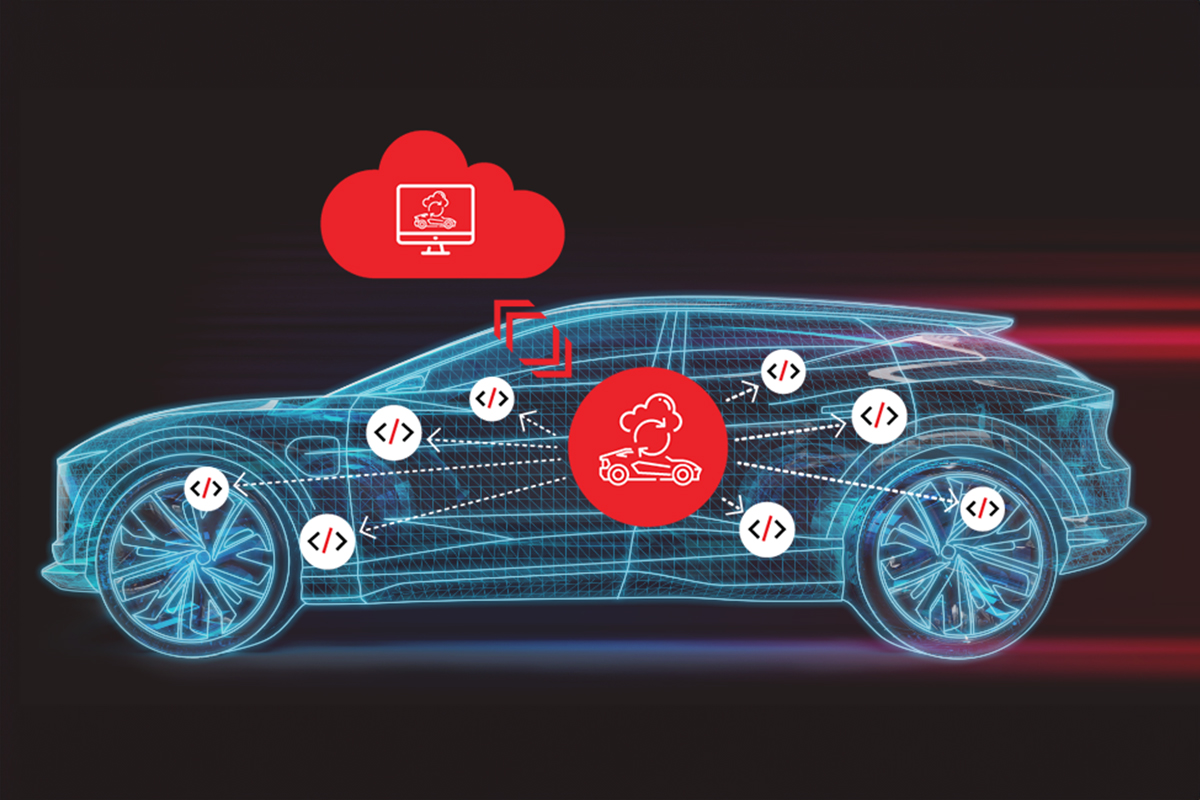The Garage Podcast : S2 EP4
Roger Lanctot from TechInsights
Longtime automotive industry analyst and expert Roger Lanctot from TechInsights joins Sonatus Chief Marketing Officer John Heinlein, Ph.D., to discuss the automotive industry’s evolving use of vehicle software, the trends at the Consumer Electronics Show for vehicle technology such as artificial intelligence, vehicle personalization, and more. Filmed live at CES 2024.
Listen to audio only version:
Episode Transcript | Roger Lanctot from TechInsights
Table of Contents
- Overview
- On CES 2024 and car shows
- Software more visible at car shows
- ChatGPT in the car
- L3 ADAS frees eyeballs for other content
- OTA solutions tailored for vehicles
- Evolution of vehicle architecture
- Integrating vehicle subsystems in new ways
- Vehicle personalization
- The role of machine learning in vehicles
- Using connectivity to enable optimization
- Raising peoples expectations of vehicles
- Changing OEM relationships with drivers
Overview
Welcome to the Garage. Today we’re live at CES 2024 with Roger Lanctot. Let’s go.
Welcome to the Garage. We’re excited to kick off season two of The Garage with recordings live at the Consumer Electronics Show 2024. We’ve got a podcast studio in our booth and we’re excited to meet with industry leaders of all types. Our first guest – and you’re the inaugural guest in our studios – Roger Lanctot from Tech Insights. And Roger’s been around the industry for a long time, has an incredible perspective on automotive and technology. And we wanted to have him in and give us his perspective on how the industry’s going and what he’s seeing at the show today. Roger, welcome to the show.
Thanks a lot. Good to be here.
On CES 2024 and car shows
Pleased to have you. So we were just chatting before we started that the show, this continues to evolve. I think every year it evolves a little bit. So I’d love to hear, you know, tell us about what you’re seeing at the show today. What are some of the big trends you’re seeing and what you think is important?
Well, the good news, I think, is that the show is all about the ecosystem around the automotive industry. So some big names pulled out. They’re not here. I think it’s probably unfortunate. If I’m GM, I’m probably rethinking that decision because they keynoted the last two years and they basically ceded, you know, technology leadership to the likes of Volkswagen with their ChatGPT announcement and other automakers who are making very significant announcements here.
But it highlights the ecosystem. And the key issue here, particularly here at Sonatus, is software. And when you’re designing vehicles, starting from software as opposed to starting from the hardware. And that I think that message is coming through here. I look at it in many respects, you know, COVID just decimated the auto show space. And so Frankfurt, the Frankfurt auto show, came back as IAA mobility in Munich.
And all of a sudden you have not just cars on the show floor, you have all the supplier community interspersed. It was a much more diverse show this year. Yeah. So that’s helpful to me because automakers, generally speaking, I’m not a huge auto show fan because automakers really don’t want to talk about what they’re doing or how they’re doing it.
It probably has a lot to do with the long development timelines. And so they want to you know, they think it’s a defense industry or anything. They want to hold the cards close. So having the ecosystem creates more opportunities to find out what’s kind of going on out there, what’s working, what’s not working, what’s in the labs, what’s being put into a proof of concept.
And so it’s a content, it’s a data, it’s a software conversation. And if you’re an automaker today, you’re trying to optimize your platforms. You want to shift-left. You want to get, you know, to market faster. You want to have a platform that’s, you know, nimble for deploying services and apps and of course, keeping the services and apps and applications that are already running in the vehicles up to date. Make- understand how they’re being used by the customer.
Right. And evolving those solutions. So that’s where the conversation’s going at this event, which is great. I mean, I’d love to see, you know, fancy cars on the show floor, but I frequently say I’m not a car enthusiast.
Software more visible at car shows
Well, I’ve been to many car shows as well. And while I might enjoy them, you know, visually, it’s interesting. You don’t get under the hood if you will, metaphorically or as we say in The Garage. You don’t get to see behind the scenes, which is what’s really taking you to the next level. So I think that’s an interesting observation. And I agree with you that this year, IAA, Autotech, a number of these shows, we’re really focusing on a little bit of the ingredients, I think. I also think and I think you agree that while OEMs aren’t necessarily want to show their cards, I think there’s a general trend, I would say a universal trend, for OEMs to care a lot more about software than they ever did before. There was a lot of “Oh software’s that thing buried in the thing that the Tier one delivers to me”. But now OEMs are saying, “no, I want to be involved in the software” or own it, depending on the perspective, more than ever before. Do you agree with that?
Well, we hear every day about the software-defined vehicle. It’s getting a little tired and almost everybody immediately says it’s all about software updates and this and that. There’s a number of different factors at work. There’s yes, there’s the software, there’s data, and there is managing that experience. And it’s software that really gives OEMs the power to create new experiences, new engagement with the customer. And so, you know, it’s fine to have all this hardware, cameras, and sensors around the vehicle, but what are you doing with the information? How are you making it safer to drive the vehicle? How are you making it more pleasurable? And so that’s why in many respects, at this event, you know, the whole artificial intelligence play is such a big deal. And artificial intelligence is going to play in everything. It’s going to play in automated driving, it’s going to play in making sure the driver is paying attention to the driving task. So the level 2 plus applications like Super Cruise with GM. And that kind of stuff is game-changing, you know. Super Cruise where you have to have an OnStar subscription so that you can take your hands off the wheel while you’re driving as long as you’re paying attention. So, okay, I’m going to subscribe to a safety system in the car that’s allowing me to have a semi-autonomous driving experience. So that’s setting the stage for level three and beyond. And then, of course, the artificial intelligence and speech recognition. So interacting more naturally with the vehicle, not the vehicle telling you, okay, this is what you can say.
This is the vocabulary you can use. Which is so limiting, right? Who wants to- My mom doesn’t want to learn the damn vocabulary, right?
ChatGPT in the car?
You just talked actually- and you and I were sharing experiences that that’s really changed. And now most of the voice assistance in cars are getting a lot smarter. And then you mentioned an announcement from VW just- it was just today, I think.
So VW- Well, it was yesterday at the big press announcement to- VW bringing ChatGPT in the car. So, what? They’re bringing ChatGPT- My God, there must be so much storage or they’re going to have huge wireless costs. No, it’s obviously a customized version developed in cooperation with Cerence, Chat Pro, I think is the solution. And that’s what the talk is all about. Customized voice assistants going into cars. Finally, because when I look at cars and when I think about cars, the car is basically, it’s a browser, okay? And I think there’s this company called Google that’s turned, you know, turned that business into a like a nine-figure business of the kind of search that we do on computers and phones and all that.
L3 ADAS frees eyeballs for other content
Yeah, you mentioned Super Cruise. And, you know, I also, I’m really appreciative of my L2+/3 kind of autonomous driving, you know, ADAS system I have in my car. I think as of course, we raise the level of autonomous driving up and up and up. Eyeballs now become available to do other things, whether that’s entertainment, news, information services. So I think the leaders—my view—is the leaders who are anticipating the future realize that they want to do these things because there’s going to be additional opportunities for value creation, for engagement, maybe revenue, you know, depending on how you do it down the road, if you anticipate that.
Well, I don’t know if you saw at the beginning of last year, a little bit later than right now, the Mercedes-Benz Investor Conference, where they were showing in the front seat video, social media, gaming, and video conferencing. And anybody who’s, you know, in the safety side of this industry was, you know – aghast! —Freaking out, like, what are they talking about? Well, they’re talking about level three, level three automation. And, you know, I was in some conversations earlier today. You know, it’s, you know, level three’s either not going to happen or it’s going to be very low numbers. I think people are really underestimating you know, the drive in the industry to deliver level three solutions.
I totally agree with you. Like level three is obviously going to happen. I think we talk four and five is a different conversation because there’s a giant gap between three and four. But three is possible for certain scenarios. Highway driving, other kind of scenarios where you can imagine actually highways more efficiently utilized. You can actually imagine vehicles being safer in level three than non- not a level three.
OTA solutions tailored for vehicles
So we were talking earlier about some of the other trends, and software updates are important. And we’re really proud- Just last week we announced our OTA solution. We think it’s a much more powerful solution than the ones out there because we were also mentioning that there’s this feeling from some people that a car is a smartphone on wheels, but I think that that’s actually really the wrong way to look at it, because vehicles have safety issues. You can’t just reboot your vehicle when you when you have trouble.
No.
So the level of care and the level of diligence has to be a much higher level. Of course, safety certification, there’s a number of critical standards. We comply with all that. But what are you seeing with OTA, and what’s your view of how OTA fits into the larger landscape?
Evolution of vehicle architecture
So the reason why a car is not a smartphone on wheels is because you have multiple processors, multiple networks – Multiple subsystem — multiple subsystems and multiple operating systems. So it’s just not like a smartphone at all. And so the challenge of getting to centralized architecture in the car with ethernet, you know, as much as possible deployed. Even in the not too distant future, centralized storage in the vehicle is… it’s a giant leap for the industry. So the industry is trying to sort of increment its way there, which is just incredibly painful. So, you know, I think of automakers having all these teams that are assigned to different ECUs, it’s like, we’re combining your ECUs, you know? No, you know.. I’m Ensign No Name, I’m not coming back from the surface of the planet or something, you know, like Galaxy Quest. So it’s an existential crisis for for all involved to change completely the way we’re thinking about the vehicle. And, you know, with, you know, hundreds of suppliers with all their different ECUs and all their different operating systems, you know, to grab all of them simultaneously and say, we’re doing things differently now.
Right.
Because we need to have a much better grasp on how all of these systems are interacting. And while we could kind of figure it out and make it work, it’ll be a lot easier if we basically hit the reset button and get as close as we can to a centralized architecture.
Yeah, and I think that I agree with you and I think the OEMs that are doing—and I won’t name names—but the OEMs that are doing I think the best work are ones that are, as you say, pressing the reset button, starting from a newer platform instead of trying to bolt on something on the side because bolting on is not going to work. You need—and now my slight hesitation is I don’t think a fully, fully centralized where there’s one computer and it does everything—that’s some generations away. But there are steps in between zonal architectures as a first step where instead of having 17 systems in the left quarter quadrant of the car, you can consolidate those into a zone.
Yes.
It’s much better. Then you connect with, as you said, Ethernet, We really believe strongly in Ethernet. One of the things we do is work on Ethernet to can interfaces and the reliability around those is very important. And then as you said, consolidation of the compute into, for example, key domains, IVI, gateway, ADAS, those are typical ones you’re seeing and it’s an evolution that allows us to go towards that central future.
Integrating vehicle subsystems in new ways
But you know, you look at something as basic as the backup camera. When that came on the scene, it’s hard to over estimate the impact that it had. Basically the radio went away, OK, because and all of a sudden your safety system is interacting with the infotainment system, right? And now we’re mandating driver monitors.
Right.
And that is going to have to have an interaction, you know, that the driver is not paying attention, that something has to take over. We’re getting intelligent speed assistance, which is going to be pushing back on the pedal when you’re speeding. So, I mean, I understand what you’re saying. We can’t snap our fingers and go to a centralized architect.
Oh, but it’s absolutely happening.
But all of these systems need to interact.
Vehicle personalization
Absolutely. Absolutely. Exactly. And, you know, we also talked a little bit about vehicle personalization. It’s something we’re showing here at the show this week. We think that personalization is something which has rolled out. You’re seeing the high end vehicles, you know, high end Mercedes and, you know, perhaps Tesla and some of these vehicles that have some personalization solutions. But your average vehicle tends to be pretty rudimentary in what’s personalized out there. I think there’s an opportunity. And what we’re hearing from the industry is there’s an interest in an opportunity because if you come back to the smartphone example, people do want a customizable smartphone and my phone and my wife’s phone and my daughter’s phone are completely different.
Yeah.
So I think they want to have their own experience. We’re trying to bring some of that into the vehicle so that people’s- feels familiar to them when they get in and they’re,my needs and, you know, your needs might be different. What’s your take on personalization?
I think the challenge that the industry has is low expectations (sings) “lowered expectations”. You know, I mean, it’s like, it’s a car. you know, I’m not expecting this thing to do anything. But the reality is like with my Hyundai Ioniq5, I have a connected radio. And the opportunity there to interact with that content management platform basically in the car, it’s not just a car stereo anymore. And so then I, as the developer of that system, as the automaker and supplier to the automaker, I need to be thinking about can I just ask it to like find a podcast on this topic or find the next, you know, rock station up the dial. Is this the only NPR station in the area that I can receive to this, or, you know, just interaction with the vehicle? Now, what did Volkswagen show? And I don’t know if you saw the press event yesterday, but it was- it seemed a little bit silly to me. So they were asking the chatbot solution to tell a story about dinosaurs, which is sort of a classic generative AI kind of proposition. And it started to tell a story. I’m not sure people are looking for that. The things that make sense to me are when my BMW tells me it wants me to take a detour, can you tell me why it’s making this detour? Because I’m seeing a lot of arrows and, you know, it looks like a picture of a crash on the screen or something. Do you have an explanation of what’s on the road ahead that you’re telling me to do this?
Or can you take me to the next Starbucks that’s on the way?
The role of machine learning in vehicles
Starbucks on the way? I mean, I don’t know if you remember deCarta, they were, their goal was, to create a search engine in the car that was tuned to automotive applications to do exactly what you just said. I want the thing that’s ahead of me, not the nearest thing.
Not the one that was five miles behind me or ten miles by me.
Yeah. So personalization, I think speech is going to play a big role. I think people are becoming more comfortable with speech on their mobile devices, on their smart speakers. And I think there’s an expectation in the car. You know, I think I told you a little earlier about my one of my sons telling me, Dad, just tell the car what you want to do.
And he was dead right. And you were surprised it just worked without having to learn vocabulary.
Well, right. And he didn’t know anything about, you know, soundhound or natural language understanding. He’s just a Google voice, you know, pixel phone user and using Android Auto in his car. And so he’s doing Google Voice all the time. That’s- this is how he does it. And that’s I think the way it’s going to go.
If we back off from voice and from sort of ChatGPT which I think is interesting and that’s going to continue to evolve. And we talk more generally about machine learning. I mean, I think there’s other aspects of machine learning as well. Two things we’re showing here is using machine learning to do better data analytics helping, for example, ADAS engineers identify weaknesses or failures in the ADAS algorithm for faster tuning cycles. We’re also showing an approach to do better closed-loop optimization of components. And the benefit is once you get data to the cloud, you can do more clever optimization, including in general with ML than what was possible before. Do you see ML as having a growing role more generally in the vehicle?
Well, ML is already playing a role in the Intelligent Speed Assistant application in order to keep that up to date and accurate. Because there are requirements for accuracy. You have to have either some cutting edge computing solution or something off board that’s gathering and processing the data. I have lane keeping that one of my sons turned on in my BMW and I don’t know if anybody listening to this has had the experience of using Lane keeping in a BMW, but it’s extremely aggressive. And I- I’m concerned that if we don’t have the means to tune these systems and identify when customers are having a problem with it, that people are just not going to use these safety systems. So understanding how the customer is responding and even making it easier to understand them and how they’re how they work to turn it on. I’ve left it on, but it is sometimes actually frightening the way it works. But when you think about those things like lane keeping, like intelligent speed assist, which is going to push back when you start speeding, even though you can push through and keep going.
It’s reminding you you’re getting to the speed limit now.
Yeah.
You might want to ease up.
Using connectivity to enable optimization
So this is a very different. This is, you know, into the realm of semi-autonomous driving, assisted driving, which is great, which is awesome. But it is going to require connectivity, customer engagement and the ability to tune these systems remotely.
It’s something -– and it’s the number one demo we show when you walk in the booth — we show how..Imagine you have a scenario where automatic emergency braking is missing pedestrians in a certain intersection. Well, why is that? Is there a glare there? Is there’s something with the signage? And so we show how that process, which typically would be a very brute force, you know, put a SSD in the trunk and drive it for a couple of weeks. Instead we can collect that data in real-time, take it to the cloud, do pedestrian detection and zero in to the ADAS engineer in days or hours. These are the kind of failures where it’s like, “Oh! I see what’s happening.” And you can deploy a new model.
So that was what was a little bit different about the messaging in last year’s Sonatus booth. It was tracking those kinds of events or scenarios where something, you know, what’s happening with those cars in that region.
Right.
Or in that neighborhood if you want to go there.
Yeah.
And how can we straighten that out?
Yeah.
Yeah.
Exactly. So we’ve gone- we’ve continue to go down the field showing the connection with the cloud in the case of in this demonstration showing how with AWS we’re able to leverage both their ML models and the cloud, other kind of manufacturing data, because you might find, well, maybe it’s just a revision of some camera that had some issue. Ah. I see now the correlation of this camera version had a problem the other camera version doesn’t. So it’s just bringing this data together I think is important. That’s where the benefit of the cloud I think we we see.
Raising people’s expectations of vehicles
I think I said that people have very low expectations that come with the cars. At the same time, I think they arrived at those low expectations because they had other expectations. For example, my sort of bugaboo about cars is cars shouldn’t hit things. Okay. Like why did- why is this car able to hit things? It shouldn’t hit things. Okay. And so just that sort of fundamental understanding. So I think consumers, even though they have low expectations, there is a simultaneous different expectation that the car maker- how could they not know that this system is failing?
Right.
And how could they not do something about it?
Right.
It’s unconscionable because it’s a living, breathing thing and the carmakers are responsible for the care and feeding of that living, breathing thing.
Well, I’m excited to see the regulatory changes. I mean, people have bad feelings about regulation, but I see a lot of sensible regulations, for example, requiring automatic braking and things like that. You know, goal for low pedestrian fatalities is a fairly universal goal across most of the world. I think generally they’re doing well, certain places are still struggling.
But Europe’s got a pretty significant lead on the U.S.
Yeah, they do. Yeah. But I think that the right things are happening and so we’re trying to help with that in trying to help speed up the feedback loop, if you will, so that when when things go wrong, we can tune it and have a response time in days or hours as opposed to months, because that makes a big difference.
So the solutions you were showing last year and the evolved solutions you’ve got here are continuing to tell that personalization story, the ability to respond to changes in how systems are functioning and where they need to be tuned and needed additional attention because I think we’re moving into a space of having a very different relationship with cars. You know, it’s nothing- you’re not messaging about this here particularly, but cars are going to be payment platforms. And, you know, that has implications for, you know, just what you’re doing in and with the vehicle.
Yeah.
And there’s- It’s almost shocking the experience that I’m- that I have between the I’ll say the unnamed brand 2022 vehicle from one car company and the other. The primary big difference being, you know, just that speech implementation-
Makes a big difference.
Makes a very big difference and just changes how I’m interacting and I really miss that.
I have two different brand cars, which I will also not name the brands, but in the experiences- Actually they’re both good, but they’re a little different. And you can see the how that difference really impacts the user experience, the driver experience.
But then we all have our friends who have Teslas and they’re getting new features and functions on a monthly basis and that’s how I think there’s a sneaking, enhanced expectation creeping into the average consumer’s mind.
And I think the general- Tesla is pushing forward in this idea of seeing those changes more frequently. And that’s, as you said, kind of those low expectations, I think changing people’s expectations. Oh, it’s possible to have updated features. And I think what we’re trying to do actually in everything we do at Sonatus is to make it possible to have the- because it’s not just delivering new software. You also have to have the infrastructure in the car that can enable those features. We’re trying to provide that flexible infrastructure that when the new feature idea comes, it’s possible to implement.
Changing OEM relationships with drivers
And it’s also dealers need to step up to explain some of these things, Some of these capabilities or automakers need to change how they’re interacting with consumers because more and more cars are coming with a lot of added functionality, a lot of added capability that the average consumer doesn’t even know is in there. And the messaging is is not great. And the electrification is changing the whole thought process of the consumer. People are putting in solar panels and storage and battery chargers in their homes. It’s changing the entire relationship with the car, with the power grid. And, you know, I mean, I think about, you know, when you’re driving and sort of, you know, eco-regen mode, the car is default to a safer proposition because as soon as you take your foot off the accelerator, it’s slowing down. Oh, that really changes the whole value proposition, the whole experience of driving a car. And also with my EV, I’m tied in to- So there are apps that can you can link to the car just tapping into the API. So using SmartCar…I use the recurrent app and I’m getting a monthly report of what the value of my car is on an ongoing basis.
That’s great.
What all the vehicle performance is. How does my battery usage compare to other owners of the same vehicle? You know…am I or is my wife charging it appropriately and things like this? These are really powerful concepts that I heard about with internal combustion engines of educating the customer. And the better educated the customer is, the more likely you are to retain that customer. So I like the messaging at Sonatus last year and this year around that sort of brain in the cloud with access to how the vehicle’s architected, what’s working, what’s not working, and with the tools to refine and enhance the experience. So this is a place at the show where the message comes through loud and clear.
Yeah, I really appreciate the kind words. We always value your feedback. You always give us great counsel. We’re thrilled to have you and I’m so glad for you joining us, taking time out of your busy day to visit with us. Thanks a lot. Enjoy the show. And maybe next time we’ll have the whole hour conversation. Just on electrified vehicles, electrification. I’ve been driving electric now and it’s a game changer. And that’ll be our next conversation.
Okay.
Thanks for joining us.
All right.
Thank you for joining us in the garage. Look for more episodes here at CES and beyond. We’ll see you again soon.
Recent episodes
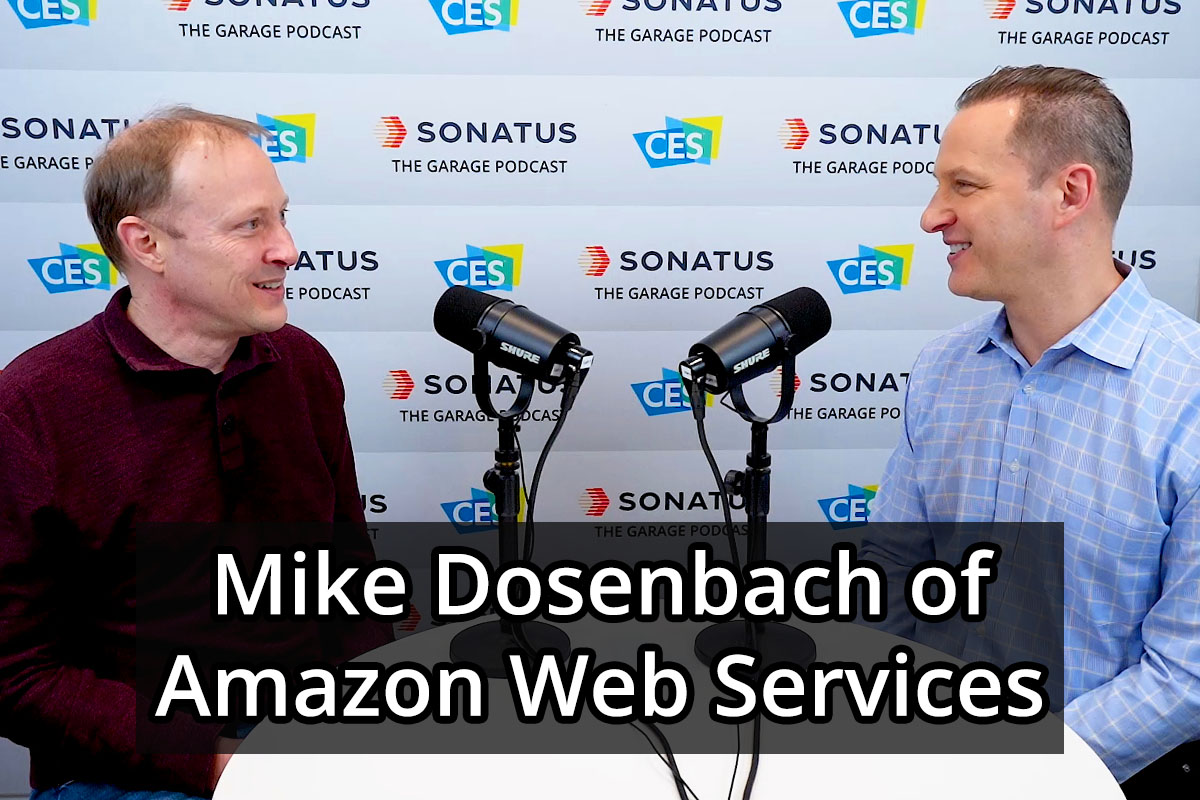
The Garage Podcast
Mike Dosenbach of AWS
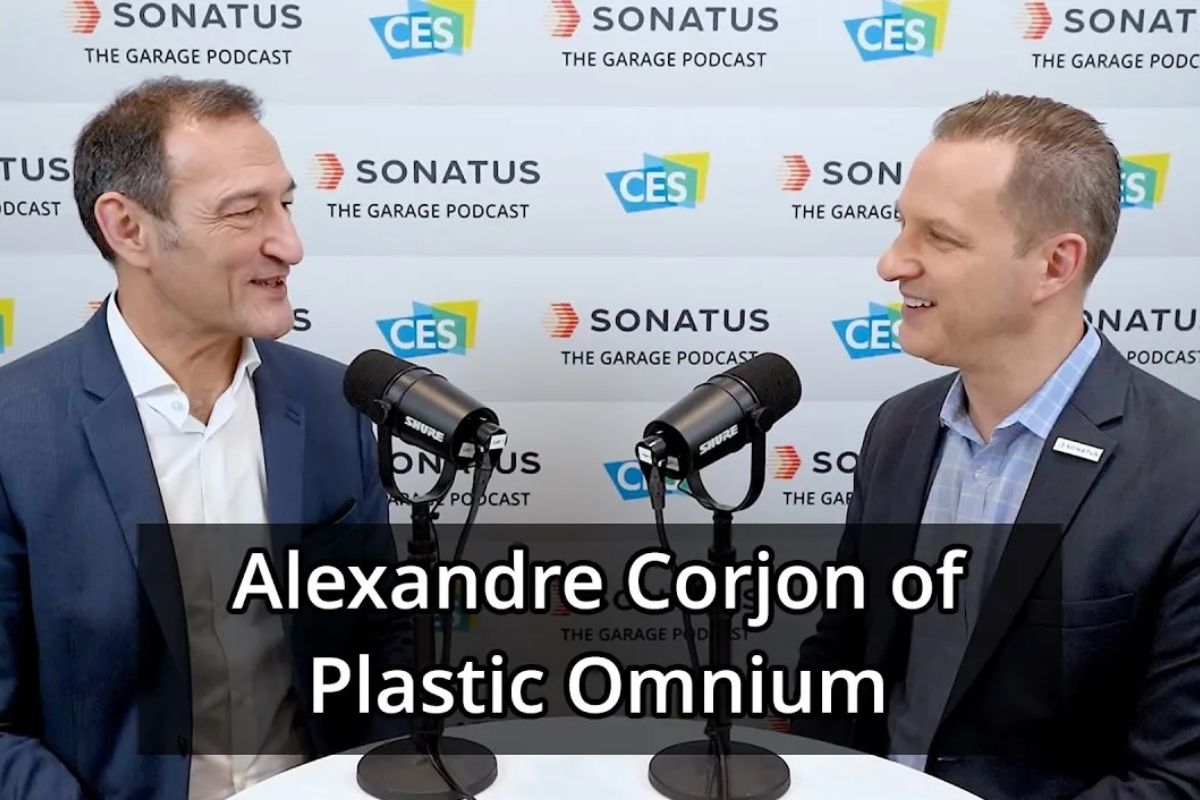
The Garage Podcast
Alexandre Corjon of Plastic Omnium
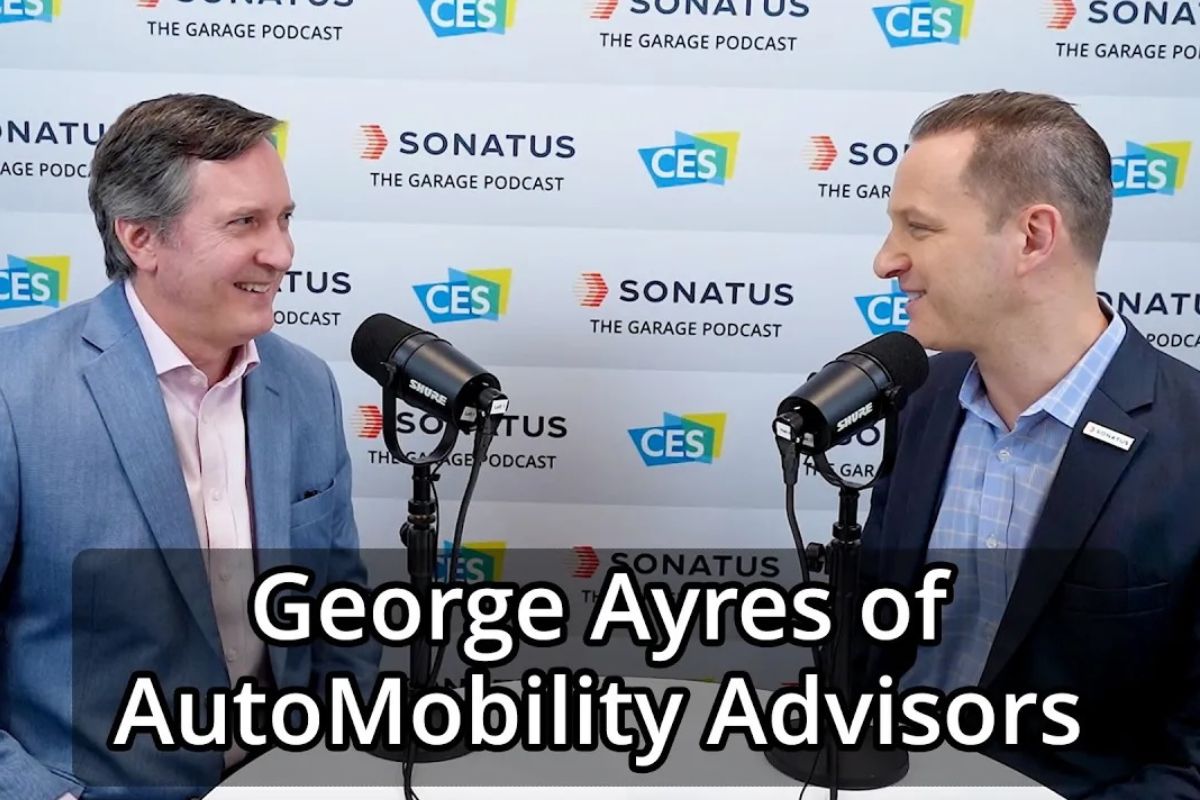
The Garage Podcast
George Ayres of AutoMobility Advisors
Related resources
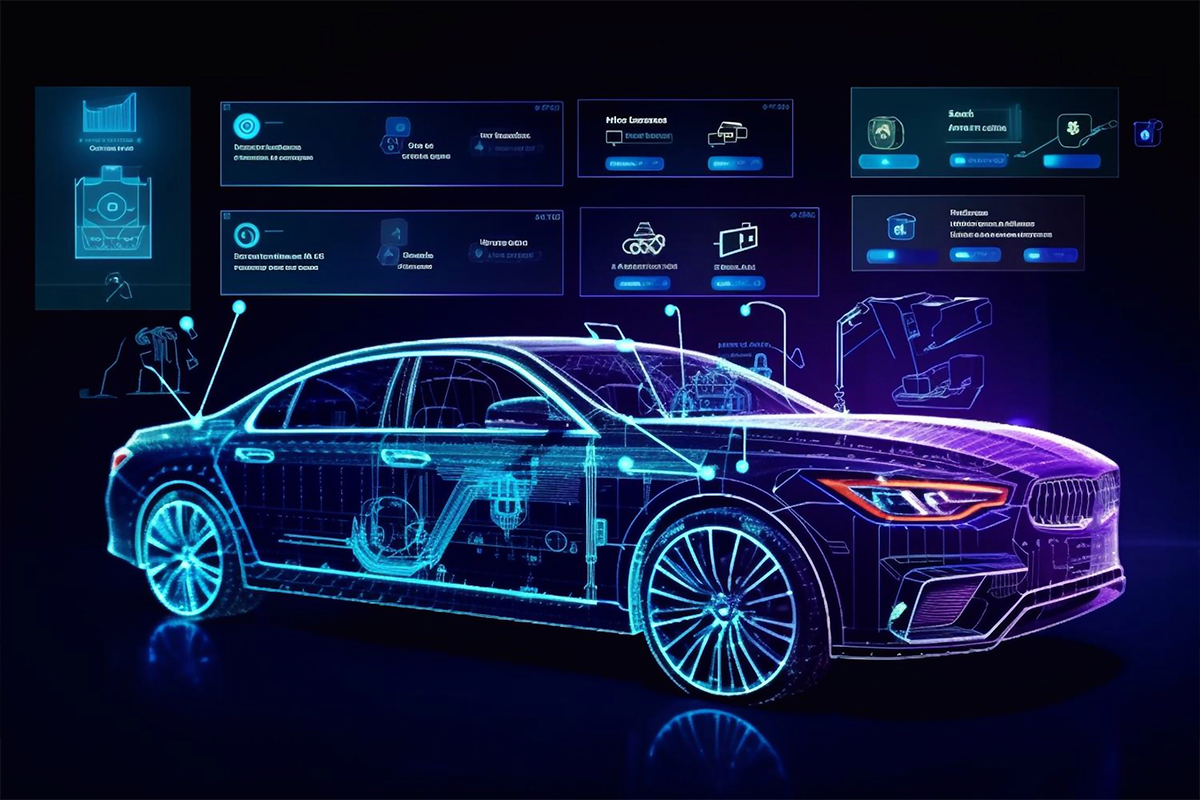
The Definitive Guide to Software Defined Vehicles
These days, the automotive industry is talking about software-defined vehicles (SDVs), but not everyone understands what this means. Don’t all vehicles already have automotive software inside?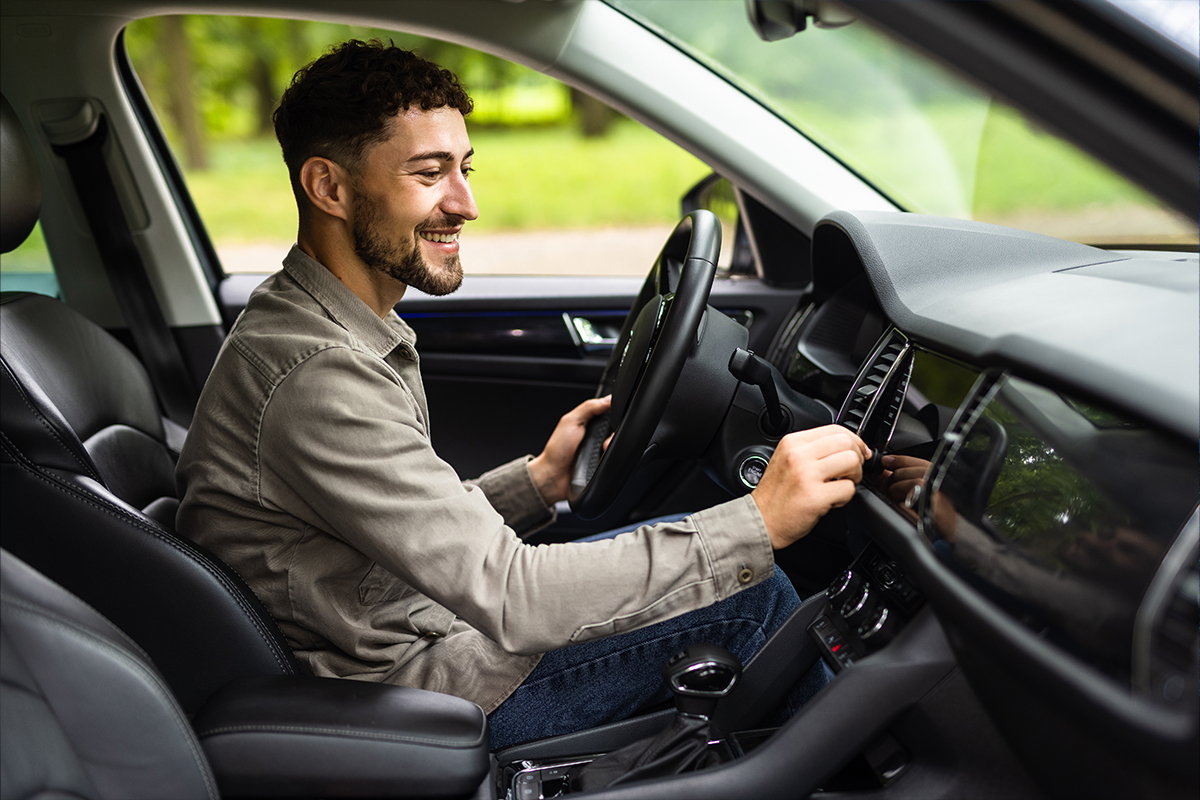
The era of personalized vehicle experiences is here
Our recent episode of “Driving Innovation” featured Jimmy Yang, Product Manager at Sonatus, in conversation with our Head of Product…